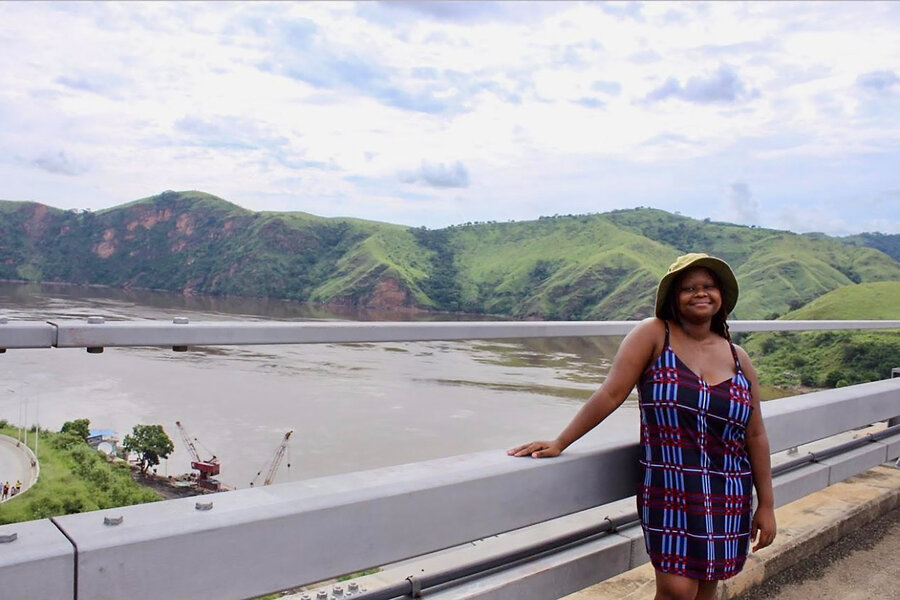Last year, South African travel blogger Popi Sibiya found herself cruising the canals of Ganvié, a village on stilts in the middle of a lake in Benin. As she sat in the back of a wooden canoe, she pulled out her smartphone and began broadcasting the experience to her 40,000 Instagram followers.
Ms. Sibiya is a former kindergarten teacher who has spent much of the last two years crisscrossing the African continent on public transportation. She’s part of an emerging group of young African women travel bloggers who are using their social media platforms to redefine what adventure travel looks like in Africa – and who gets to experience it. They are pushing back on the stereotype that travel on the continent is the exclusive domain of khaki-clad Westerners on safari – and inviting their mostly African audiences to do the same.
Why We Wrote This
A story focused on
With a few exceptions, African countries are rarely featured on global “where to visit” lists. Now, women travel bloggers from the continent are writing themselves into the story.
“We don’t have to rely on traditional media [anymore],” says Rosalind Cummings-Yeates, an African American travel journalist who frequently works in Africa. Instead, would-be travelers can scroll the feeds of influencers like Ebaide Joy, Instagram alias @go_ebaide, a Nigerian adventure traveler currently riding her motorcycle from Nigeria to Kenya.
This generation of influencers is “call[ing] out ignorant stereotypes” and “expand[ing] the image of Africa,” Ms. Cummings-Yeates says.
Last year, South African travel blogger Popi Sibiya found herself cruising the canals of Ganvié, a village on stilts in the middle of a lake in Benin. As she sat in the back of a wooden canoe, she pulled out her smartphone and began broadcasting the experience to her 40,000 Instagram followers.
“My lover is paddling to me as we speak,” she joked, giggling as a man propelled toward her in a water taxi.
Ms. Sibiya is a former kindergarten teacher who has spent much of the last two years crisscrossing the African continent on public transportation – and now has over 100,000 followers. She is part of an emerging group of young African women travel bloggers who are using their social media platforms to redefine what adventure travel looks like in Africa – and who gets to experience it. They are pushing back on the stereotype that travel on the continent is the exclusive domain of khaki-clad Europeans on safari or sunburned Americans sipping cocktails on Zanzibari beaches – and inviting their mostly African audiences to do the same.
Why We Wrote This
A story focused on
With a few exceptions, African countries are rarely featured on global “where to visit” lists. Now, women travel bloggers from the continent are writing themselves into the story.
African travelers “are starting to prioritize fun and adventure” on their own continent, says Ms. Sibiya, whose followers are mostly well-off South Africans used to traveling to Europe, the Middle East, and Asia for their vacations. On her account, “they see that we also have beautiful beaches; we don’t have to go to Thailand,” she says.
Documenting a different Africa
Each year, African countries clock more than 80 million visitors, and the industry generates about 25 million jobs, according to the World Travel & Tourism Council, an industry advocacy group.
Still, African countries are rarely featured on global “where to visit” lists – at least outside stock-standard international favorites like Morocco, Mauritius, South Africa, and Egypt.
Ordinary travelers with large social media followings are filling that void, says American travel journalist Rosalind Cummings-Yeates, who has traveled extensively in the region and often uses travel influencers to help plan her trip.
“We don’t have to rely on traditional media [anymore],” she says. Instead, would-be travelers can scroll the feeds of influencers like Ebaide Joy, Instagram alias @go_ebaide, a Nigerian adventure traveler currently riding her motorcycle from Nigeria to Kenya. Or like Ess Opiyo (@ess_opiyo), a Kenyan travel guide with a passion for offbeat destinations. This generation of influencers is “call[ing] out ignorant stereotypes” and “expand[ing] the image of Africa,” Ms. Cummings-Yeates says.
Margot Mendes has seen firsthand the power of social media to transform how people travel in the region. She lives in Dakar, Segenal, where she works in marketing. She puts the same skills to use on her Instagram account, @thedakardream, where she shares her life and travels with her 33,000 followers.
Her grid features scenes from bustling open-air markets, peach-colored sunsets overlooking cerulean hotel pools, and glimpses of local cuisine including baguette sandwiches and spiced rice dishes.
Ms. Mendes started the account five years ago, when she moved back to Dakar from Paris, where her Senegalese and Bissau-Guinean family had migrated when she was a child. Originally, the page was just to show her worried friends and family in Europe how much Dakar had transformed in the decades since they emigrated.
“It was just me being curious about my culture and going to places to discover my own culture,” she says.
But soon her page began to gain an audience beyond people she knew. She says her new followers – most of them African – told her they loved seeing their own continent branded as a glamorous travel destination for the first time.
Complicating the story
Ms. Mendes’ account has the feel of a glossy travel magazine, but for many young African women documenting their travels, it is important not to shy away from the continent’s struggles – or the challenges that make travel there tricky to navigate.
Recently, for instance, Nigerian British travel blogger Pelumi Nubi completed a 10-week road trip from London to Lagos in a purple four-door Peugeot 107 she named Oluwa-Lumi – Lumi for short. It means “God lights the path” in her native Yoruba.
Ms. Nubi documented the journey for more than a quarter million people on her Instagram account, @pelumi.nubi. Her posts bounced between travel highs – like when Lumi the Peugeot’s wheels touched African soil for the first time in Morocco – and lows – a video of Lumi’s crumpled hood after she slammed into a parked car on a dark road in Ivory Coast.
“You have the people who are trying to paint [Africa] as a war-torn place, a dangerous place, and then you have the people who are trying too hard to sell it as this paradise,” says Ms. Sibiya, whose page cheerfully records her travels in rickety buses she describes as “hearses” and doesn’t shy away from her brushes with poverty, bad roads, and chaotic border crossings. “I document Africa in a balanced way,” she says.
Ms. Sibiya says her audience is mainly other South Africans, many of whom tell her they are experiencing the continent’s beaches, safaris, fancy hotels, and restaurants for the first time through her account. For many, the issue is partly cost. Counterintuitively, flights between African countries are often more expensive than flights from the continent to international travel hubs like Dubai in the United Arab Emirates or New York. And instead of high speed trains or rental cars, overland travelers often have to choose between taking rundown public transport or paying up for a private car and driver.
Ms. Sibiya funds her travels through paid subscriptions to her Instagram account, which cost 140 rand (about $7) a month and give access to more detailed and frequent travel updates than her public page. Currently, she has around 1,200 subscribers.
She believes social media influencers like herself have become a trusted source of travel information because of their commitment to showing an authentic side of Africa.
For her, this authenticity is embodied by a recent experience she had in Zanzibar, where she got lost on a cobblestone street in Stone Town. It was clear she was clueless, she says, but no one tried to hustle her. Instead, a group of children guided her back to a main square and told her, “Hakuna matata” – Swahili for “don’t worry.”
“They are very aware of the beauty of community, the beauty of kindness,” she says.









